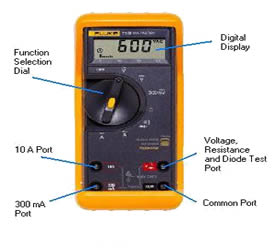By attaching two leads to different parts of an electrical system, professionals can use multimeters to detect levels of voltage and resistance, or changes in electrical currents. It is an all-in-one electronic measuring instrument that combines several measurement functions.
Thus, it’ll be able to troubleshoot issues with your circuit or electronic designs! The two main kinds of a multimeter are analog and digital. A multimeter measures the electrical properties of a circuit. A digital device has an LCD screen that gives a straight forward decimal read out, while an analog display moves a bar through a scale of numbers and must be interpreted.
Various tests can be run and measurements made depending upon the setting. Electronic versions of the multitester are called a DMM (digital multi-meter ) or DVOM (digital volt-ohm- meter ). Each setting may also have different number values, which are there to measure different strengths of voltages, resistances, and amps. Depending on the model, it may also be able to measure continuity and capacitance, to test diodes and to distinguish between AC and DC current.
Both are used for measuring and fault detection in electrical circuits. There’s a multimeter for every occasion, from DIY electronic projects to high-voltage engineering. Now, let’s take a look at the details of a multimeter ’s operation.
The first digital multimeter was introduced in the late. Multimeters are mainly of two types, analog and digital. Your multimeter comes with two insulated probes. In most cases, these measurements are used to work out what is causing particular problems with the electrical system in question.
It all depends on the work and the type of digital multimeter that you want. A meter is a device that measures electrical quantities in your electronics projects.
At the minimum, a multimeter combines three distinct types of meters (ammeter, voltmeter, and ohmmeter) into a single device. Number 1: Hold Button.
This button will "hold" whatever the meter reads after you have pressed it. From changing a junction box to installing a ceiling fan, using a multimeter helps to determine if wires are properly connected or not(and so much more). What is multimeter ? In the picture is an example of a digital multimeter.

This instrument will let you check to see if there is. The labels on a multimeter can seem like their own language to a layman, and even people with electrical experience may need a helping hand if they encounter an unfamiliar multimeter with an offbeat abbreviation. A multi-meter can save the average person a lot of money over a few years, even though ladies who choose to buy one may not carry it in their purse when going out for the evening.

You will often be able to solve many problems yourself in less time than it would take to get a technician to come to your home. Well, the digital multimeter or volt-ohm-milliammeter is an electronic measurement device that can measure voltage, current, and resistance. Most of the electricians or the people who are fond of electronic are well aware of this device.
If you are not sure how accurate your digital multimeter measurement is, find its accuracy specifications in the instruction manual, and then read this to get the rest of the story. There are two types of mulitimeter which are Analog and Digital. A analog multimeter have moving pointer which move over a scale.
A Digital multimeter display the measurement value in numbers. Electricians use a digital multimeter as a standard diagnostic tool.
A digital multimeter (DMM) is a testing tool that measures electrical values: current in amps, voltage in volts and resistance in ohms. It’s not limited to only these three measurements — it can also measure capacitance, frequency, and gain of transistors. The words multimeter and multitester are used interchangeably, but a multimeter is used for metering or measurement, while a multitester is used for testing.

Some manufacturers may argue that testers may be used just to affirm the presence or absence of voltage or current, while meters are used to measure the actual levels. Mastering some fairly universal abbreviations, and a few basic principles, will help you decipher the often-cryptic settings on your multimeter.
A false signal or incorrect result will impact on your work badly. If the resistance is too high to be measured in this range, a digital meter will display an overload message, and the pointer on an analog meter will move too far to the left to give a meaningful reading.
Nessun commento:
Posta un commento
Nota. Solo i membri di questo blog possono postare un commento.